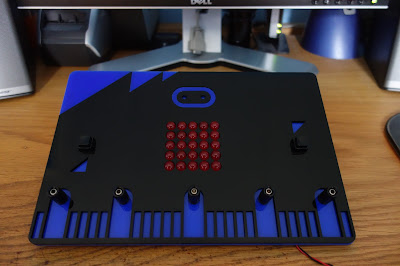During July last year Andrew Gale () tweeted details of his mega:bit which is a lasercut scaled-up model of the BBC Micro:bit. This looked interesting and I thought it would be great to build my own.
The beginnings of my lasercut scaled-up micro:bit with 4mm posts/terminals! Now for LEDs and switches! #BBCmicrobit pic.twitter.com/b30BnjPP60— Andrew Gale (@PocketMoneyTron) July 13, 2015
Teachers! Fancy making your own big version of the #bbcmicrobit ? Find out how here! https://t.co/CbKNslaIwP https://t.co/ujIqv7dP9q— Andrew Gale (@PocketMoneyTron) May 28, 2016
Step one: Assembling the PCB's.
 |
| Blank PCB's |
 |
| Populated PCB, LED maxrix side |
 |
| Populated PCB component side |
Step two: Laser cutting
I am lucky enough to have access to a laser cutter at work. I opened the CAD files Andrew sent me and cut out all the required parts in 3mm Perspex. I used blue for the back layer and black for the front layer then glued it together using special Acrylic glue. When using the laser cutter, remember Rule Zero. Do not be on fire.
 |
| Laser cut parts |
Step three: Putting it all together
Now it was time to put it all together, Andrew had sent some photos of the completed mega:bit and uploaded a video to YouTube showing how it was assembled. There is a ribbon cable connecting the buffer PCB to the phototransistor PCB, this is not shown in the diagram.
I used 4mm terminal posts for the general purpose input and output pins, plus 3V and GND, these are connected to the Kitronik breakout board. There are also two large push buttons which allows you to trigger or detect a button "A" or "B" click externally, these are also connected to the Kitronik breakout board.
 |
| Assembly diagram |
Overall I'm very pleased with how this project turned out. On a footnote I recently took my mega:bit to the CAS East Regional Conference, I'm pleased to say there was a lot of interest in it.
@MrTomsWorld at the @CAS_east regional conference with his not so micro #microbit pic.twitter.com/Xcf3JuH7he— CAS East (@CAS_east) July 8, 2016
Finally if you are interested in having a go at making your own then do get in touch with Andrew Gale.






